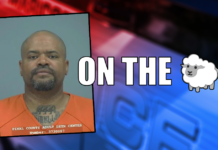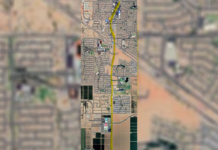
When it comes to the Maricopa real estate market, there isn’t much that Dayv Morgan hasn’t seen or experienced on some level.
Morgan, a Maricopa Realtor and the owner of HomeSmart Premier, has spent the last 13 years selling real estate in Maricopa, working fastidiously to grow his business, one sale at a time.
The seller of $284 million in real estate, he had a five-year stretch in which he sold 500 houses. Morgan lived through the Great Recession both as a Realtor and a resident of Maricopa.
Morgan has thrived by understanding the market around him and learning how to best provide the services needed by his clients.
As a Realtor, he succeeded during a period of rampant foreclosures.
As that eased, he shifted his business model to help home sellers maximize their profits.
It’s no secret that right now, the real estate market is once again changing.
With interest rates nearly doubling in the last four months, the frenzied buying behavior during the first two years of the pandemic has subsided.
Morgan said the biggest difference between now and a few months ago, isn’t necessarily price, but the longer time for homes to sell.
While it’s impossible to know what the future holds, Morgan is someone whose experience, in many ways, mirrors the meteoric rise of Maricopa itself.
A southern migration
A native of Tempe, Morgan moved to Maricopa in 2006. At the time, he was a young man who worked as a manager at a Chandler pizza restaurant and was starting a family.
“My wife and I wanted to buy a new home and the prices that we were looking at, at the time in 2006, were higher than we could afford in Tempe,” he said.
It was a chance visit one day that wound up changing the Morgan family’s futures.
“We just kind of stumbled upon Maricopa,” Morgan said. “I didn’t even really know where Maricopa was. Even though the distance from Tempe to Maricopa is not far, I’d never been out here and wasn’t familiar with it at all. But we took a drive out and looked at some homes and said, ‘Yeah, this could work.’
“Like most people, I think I was attracted by the price of homes out here, and I wasn’t in real estate at the time. Maricopa was a great opportunity to get our first home.”
Morgan found a new community with inexpensive housing in what looked to be an up-and-coming city. But in 2006, the real estate bubble that fueled the Great Recession was in its final throes. While homes were cheaper in Maricopa than the Valley, prices were getting ready to crater everywhere. A recession loomed.
When the restaurant Morgan managed shut down, Morgan figured it was time for a change.
“I was out of work and thought, ‘It’s time to maybe do something else,” Morgan said. “I enjoyed working in the restaurant business … waiting tables through college and then it helped to pay my tuition.”
Inspiration came from family. Morgan’s mother-in-law, Sue, a realtor in California, saw something in him.
“She’d always said that she thought I’d make a good Realtor, but I hadn’t really given it much thought,” Morgan said.
Morgan earned his real estate license in 2009, but even before then he was getting his feet wet in the business. He and his wife, Sarah, would go around with a Realtor looking at foreclosed properties for Sarah’s stepfather, Alan Day, who wanted to buy homes and keep them as rentals.
As Morgan spent more time on those visits to foreclosed homes with agents, he started to see what became his life’s new path.
“So, he (Day) wanted us to do the work for him,” Morgan said. “So, we’d go around, look at homes, and kind of make some recommendations. And that was kind of my first introduction to real estate and I thought that this looks like a lot of fun. This looks like something I’d be interested in doing.”
Learning a new profession
Morgan had the inspiration and the drive to follow his new calling. But he was also learning on the job. While he’d been personally affected by the recession in losing his job, he still didn’t quite understand the depth of what was happening.
“I think I was a little naive really, to where the market was,” Morgan said. “The first house we bought was in 2006, which was pretty much the peak of the market here. We paid $236,000 for that little house. It was 1,500 square feet, brand new. We loved that house.
“I don’t think we really understood what was happening with the market, until one of my neighbors made the comment that our house was only worth, you know, $100,000 or something like that. We said, ‘there’s no way.’”
Unfortunately, the neighbor was correct.
“I was really just oblivious to what was happening with the market at the time and turns out, it was worth even less than a hundred thousand dollars,” Morgan said.
The Morgans ended up losing their home and the bank sold it for $80,000, about a third of what they paid for it.

Seeing opportunity
Despite the ongoing crash of the real estate market, Morgan saw opportunity where others couldn’t.
“After that, I knew that the market was pretty low,” Morgan said. “It was an interesting time because a lot of Realtors were getting out of the market because it was really difficult to sell homes as things were declining.”
But Morgan figured out a side of the business overlooked by many other real estate agents. With a lot of hard work, he found a niche. Many homes in Maricopa at the time selling for less than $100,000, which meant that to make a living Morgan realized he was going to have to sell a high volume of homes.
“A lot of Realtors exited,” Morgan said. “I came in pretty much at the bottom and got my start there. The first house I sold was, I think $60,000. By the time I paid office fees and all those things, I think my commission was less than $1,000, but it was great.”
Morgan’s first sale, while not any kind of a windfall, was instrumental in that it inspired him.
“I was excited,” Morgan said. “I was loving my new career in real estate, but it was certainly an interesting transition from being a salaried employee (at the restaurant) to being commissioned as a Realtor. The prices were so low that, you know, you definitely had to do a high volume to kind of equal what I was making before.”
From that point, Morgan considered the work he and his wife had done for Day and figured out how to leverage that experience in helping other investors purchase foreclosed homes.
“We started out by helping him buy a few houses,” Morgan said. “And then we discovered the auction, the foreclosure auction or the trustee sale process.”

Morgan was one of many Maricopans who lost a home during the Great Recession. In many ways, the driving force behind the real estate market in Maricopa was foreclosures.
According to the 2010 Census, Maricopa’s population was 43,482. During a four-year period from 2008 through 2012, the city had 5,124 foreclosures. Using the census figure for the average household consisting of 2.5 people, which means there were about 17,000 homes in Maricopa at the time. In other words, nearly one of every three homes were foreclosed on during that four-year period.
Morgan had a thorough understanding of the market as an agent and a homeowner.
“There were so many homes in foreclosure or short sale in that 2009 period,” Morgan recalled. “About 75 percent of the closed sales in the MLS (Multi-Listing Service) in that time were either short sales or closures, or HUD homes, or auction homes. There were a lot of homes that were going into foreclosure.”
The foreclosure process is when a homeowner falls behind on their payments and the lender initiates the legal process to recover the amount owed. Homeowners are given a 90-day notice to bring their payments current. At the end of the 90 days, there’s a Trustee’s Sale, or an auction, where the lender sets the minimum bid at the amount to satisfy the loan. If that minimum isn’t met, the bank can take ownership of the property and sell it.
There were so many foreclosures and short sales in Maricopa that it handcuffed the real estate market for years. Such negative actions can wreck a potential homeowner’s credit.
“One of the challenges we had, there were so many people who lost their homes to foreclosure,” Morgan said. “They were not able to buy again. If you have a foreclosure on your credit report, banks are not going to give you a loan for another three, four or seven years, depending on the type of loan program.”
Morgan wasn’t immune to it, either.
“Unfortunately, I had bad credit, as well,” Morgan said. “I was in that group that couldn’t buy and had to rent for a little bit.”
Digging out
As Maricopans’ credit scores started to improve, a wave of investors from Canada and elsewhere came in as the city recovered from the Great Recession.
Morgan educated himself on the foreclosure process and how to help his clients benefit from it.
“We found out that you could buy those homes before they hit the MLS,” Morgan said. “You could go to the courthouse and buy them at auction. I had a couple of investors who wanted to purchase them and flip the homes.”
Morgan also learned the short sale process inside and out. A short sale is when a homeowner owes more money on a property than it’s worth and asks the lender to sell it for less than what’s owed on the mortgage note.
Each bank has a different process for handling short sales and Morgan learned them all in a bid to make sure he was first in line when those properties became available.
Morgan started what was, in effect, a concierge service for investors.
“We did everything for them,” Morgan said. “We helped to clean the houses up.”
Many times, Morgan’s investors bought homes sight unseen. There wasn’t any telling what they might find in those homes. The people might still be living there. Or maybe, they left the home, but never moved out their belongings.
“That’s an interesting process that has a lot of risk associated with it because there’s no inspection period,” Morgan said. “There’s no due diligence period. A lot of times, you are buying these homes as-is without even seeing the inside. You could drive past them and maybe find out if they’re occupied or vacant. But if the blinds were closed and the doors are locked, I mean you have no idea what the condition of the home is like inside. So, definitely a high-risk adventure for an investor because you could open that door to find everything was missing inside or it was riddled with mold.”
Morgan found his niche and success. In his second year alone, he sold nearly 80 homes.
Changes come around — again
But by the time 2013 rolled around, the market had changed again.
Foreclosures peaked in 2009 at 1,651. Both 2010 and 2011 saw foreclosure numbers surpass 1,000. But in 2012, there were only 378.
The foreclosure market was drying up. Sales were becoming more competitive. Flips that used to earn an investor $50,000, now only garnered about $10,000.
Morgan realized his focus needed to change again.
“I really started targeting sellers,” Morgan said.
“It was easy to transition into working with sellers,” Morgan said. “I transitioned to working almost exclusively with sellers doing resales as the foreclosure market changed.”
With his experience in rehabbing foreclosed homes, Morgan was poised for his next step in the resale part of the business where he, in effect, helped sellers “flip” their own homes to maximize their profits from a sale.
As part of his program for sellers, Morgan loans them $10,000 for upgrades to help their home sell quicker and for a higher price.
“I worked with investors for such a long time, flipping homes,” Morgan said. “I was able to learn what is effective when you’re selling a home if you’re going to remodel, what type of color palette or what type of appliance or what type of flooring, countertops, etc. are attractive to buyers.”
Sometimes a homeowner sells a house to an investor, who comes in and makes a few improvements and “flips” it for a quick profit.
Morgan’s thought was to bypass the investor and allow the homeowner to profit directly.
“You’re flipping your own home,” Morgan explained. “You’re going to do exactly what a flipper would do if they bought your home and were trying to make quick money on it.
“You can get top dollar, it’s not going to cost you anything out of pocket and you can just pay me back when it sells.”
Recovery becomes clear
One of the hallmarks of the Great Recession was that lots and almost brand-new homes were simply abandoned.
For many years, there was very little construction as the city used up the inventory that was on hand.
“It took about 15 years for it to fully rebound to where the prices were when I moved down here,” Morgan said. “I never had any doubts it would come back. But for me, the moment that demonstrated things were getting better was when building started again.”
For Morgan, as a resident of Maricopa and a Realtor, it’s been quite a ride that started with a chance visit to Maricopa back in 2006.
“I’ve been very blessed with a lot of success, and you know, wouldn’t see myself doing anything else,” Morgan said.
This story was first published in the September edition of InMaricopa magazine.
Editor’s note: This story was corrected to reflect that Morgan sold 500 total houses in a five-year period, instead of annually for that same period.

![O’Reilly gears up for second Maricopa location An exterior view of O'Reilly Auto Parts on John Wayne Parkway on May 2, 2024.[Monica D. Spencer]](https://www.inmaricopa.com/wp-content/uploads/2024/05/spencer-050224-oreilly-second-location-web-218x150.jpg)
![Province writer opens the athlete’s mind in new book Tom Schuman, a Province resident, poses with a copy of his new book, "My Wide World of Sports," outside his home on May 2, 2024. [Monica D. Spencer]](https://www.inmaricopa.com/wp-content/uploads/2024/05/spencer-050224-tom-schuman-sports-book-web-01-218x150.jpg)








![City gave new manager big low-interest home loan City Manager Ben Bitter speaks during a Chamber of Commerce event at Global Water Resources on April 11, 2024. Bitter discussed the current state of economic development in Maricopa, as well as hinting at lowering property tax rates again. [Monica D. Spencer]](https://www.inmaricopa.com/wp-content/uploads/2024/04/spencer-041124-ben-bitter-chamber-property-taxes-web-218x150.jpg)
![Maricopa restaurateur makes Food Network connection [Namkeen Dhaba]](https://www.inmaricopa.com/wp-content/uploads/2024/04/439456716_377105198650519_7536248579664805896_n-218x150.jpg)

![O’Reilly gears up for second Maricopa location An exterior view of O'Reilly Auto Parts on John Wayne Parkway on May 2, 2024.[Monica D. Spencer]](https://www.inmaricopa.com/wp-content/uploads/2024/05/spencer-050224-oreilly-second-location-web-100x70.jpg)
![Province writer opens the athlete’s mind in new book Tom Schuman, a Province resident, poses with a copy of his new book, "My Wide World of Sports," outside his home on May 2, 2024. [Monica D. Spencer]](https://www.inmaricopa.com/wp-content/uploads/2024/05/spencer-050224-tom-schuman-sports-book-web-01-100x70.jpg)

